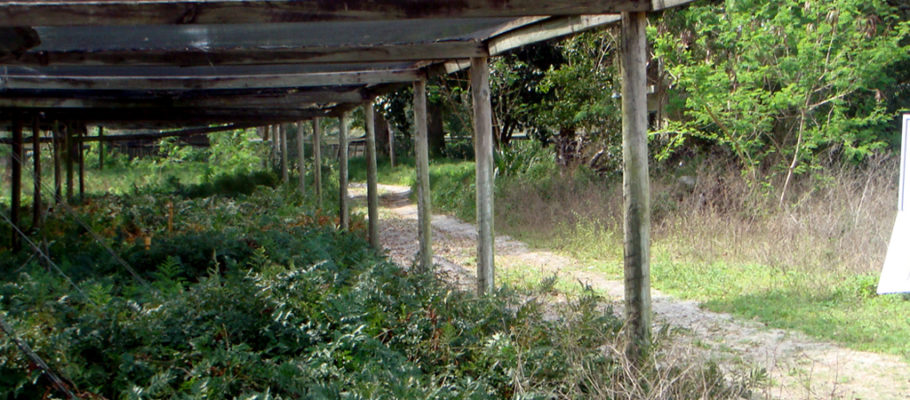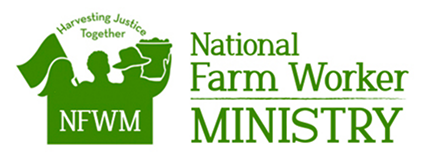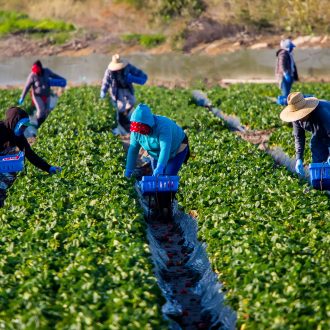
The impacts of climate change are being felt all over the U.S. through higher temperatures, increase in wildfires, prolonged droughts, frequent flooding and more frequent and stronger hurricanes. Farm workers – men, women, children, documented, undocumented, migrant, resident – are on the front lines of the brunt of climate change. As climate change forces significant agricultural adaptations and farmers continue to feel pressure to make shortcuts concerning labor, farm workers will feel the first and most severe impacts on their working and living conditions.
We urge people of faith and conscience to hear the call and stand with farm workers to challenge oppressive systems in order to bring healing to individuals, communities, and the earth.
Global Migration
According to the United Nations by 2050 there may be as many as 200 million climate-displaced persons. So-called natural disasters like hurricanes, floods, tsunamis, heat waves and droughts are becoming more frequent and devastating at an alarming rate. Increasing numbers of people are being displaced from their lands, livelihoods and homes, leaving them as internally displaced people within their own countries or forced to migrate across international borders. The Internal Displacement Monitoring Centre estimates that 17.2 million people had to leave their homes in 2018 because of disasters that negatively affected their lives.
Climate change knows no borders and no place is immune to its impact. The consequences, however, fall more heavily on those that are more vulnerable. When families, communities, and entire nations are facing poverty or political instability , the effects of natural disasters or drought are felt more acutely. Addressing climate change must go hand in hand with addressing the challenges of displaced persons and migrants. As communities of faith we can support fair and just treatment of immigrants in our own country and around the world.
Program ideas, additional resources, and more.
Heat Stress
The solutions are simple: access to water, shade and rest. Most employers do not voluntarily provide access to these remedies. Farm workers are often paid by piece rate which discourages them from taking breaks or stopping to hydrate.
Farm workers often wear long-sleeve shirts to protect them from pesticide and sun exposure, but these further increase their body temperature. Working in fields, many farm workers are in direct sunlight with no access to shade while performing strenuous work, leaving them even more susceptible to heat stress.
Unfortunately the end of the work day is not necessarily the end of the risk of heat stress for many farm workers. Worker housing often does not have air conditioning or fans. Farm workers experiencing heat stress do not have access to remedies, even including water, to lower their body temperatures. A team of nursing staff from Emory University, with support from the Farmworkers Association of Florida, conducted a study in 2018 of heat stress in farm workers across Florida. They found that of the farm workers studied: 43% began the workday dehydrated, up to 72% showed signs of dehydration by the end of the workday; and more than 80% had dangerous body temperatures on at least one day of the three-day study. As temperatures continue to rise across the nation, it is crucial for regulations to be put in place.
We can anticipate that heat stress illnesses and deaths will continue to grow unless there is an intervention. Heat illness can be prevented by access to training, water, shade and rest breaks. But as many employers will not provide these basic needs voluntarily, federal legislation is needed.
Program ideas, additional resources, and more.
Water, Drought, and Wildfires
As temperatures rise and soil dries out, there is an increase in wildfire activity. In 2018, California wildfires burned more than 1.8 million acres and caused smoke drift for hundreds of miles. What used to be a seasonal issue in the Western U.S. now lasts year round. As the intensity and frequency of wildfires increase so do the risks facing farm workers.
Direct exposure to smoke and heat from wildfires is the initial burden placed on an already tenuous set of consequences. Smoke from wildfires contains chemicals, gases and fine particles that can reduce lung function, worsen asthma and other existing heart and lung conditions. Each health risk is also compounded exponentially by global socio-economic factors. In the U.S., those include lack of immigration status and the criminalization of immigrants. Many are fearful of coming forward for assistance even when eligible. The threat of being separated from their families by detention and deportation keeps farm workers from seeking much needed services.
Unpredictable rainfall results in both drought and flooding, which create job insecurity for farm workers who are already living paycheck to paycheck. Most farm workers do not have paid leave and are not eligible for unemployment, leaving them extremely vulnerable economically. They are often paid by the piece as opposed to by the hour meaning that any time spent away from work results in a income loss. The threat of lost wages also encourages farm workers to work even in hazardous conditions like smoke. The failure of the authorities to provide sufficient notice in locally spoken languages puts farm workers at even higher risks.
Displacement of farm workers from wildfires is also a concern. Many farm workers live in overcrowded subsidized worker housing or low quality rental properties near their work sites. These situations leave farm workers vulnerable to predatory-price gouging tactics that landlords take advantage of in wildfire induced housing shortages.
Program ideas, additional resources, and more.
Pesticides
The use of pesticides has been a long-time health risk for farm workers, who are twice as likely to die from pesticide poisoning than workers in other occupations. Crop spraying can cause direct exposure, as can re-entering fields prematurely after the fields have been sprayed. Indirectly, farm workers can be exposed by handling pesticide containers (warning labels of which are still not required to be written in Spanish), contact with pesticide residue and breathing in “pesticide drifts” from neighboring fields. Inadequate training and protective gear, also put farm workers both at immediate risk as well as long-term harm.
Farm workers’ families can also be harmed by these toxins. Farm workers and their families are exposed to pesticides in their homes as many live nearby fields that have been sprayed. Farm workers can also bring the poisonous pesticides home with them on their clothes, shoes and bodies. Persistent pesticide exposure has been associated with cancer, depression, diabetes, neurodegenerative diseases and reproductive issues. The lack of access to health care exacerbates the health risks farm
workers face.
Climate change is expanding pesticide use as well as its harm. As the temperature rises, pests and weeds multiply, requiring heavier use of pesticides. Rising temperatures also can cause pesticides to evaporate more quickly, making additional application required to achieve the same effect. Warmer temperatures can also make some of the pesticides even more toxic. For example, the widely used organophosphate pesticides have been shown to increase the rate of chemical transformation into more toxic compounds.
Heat stress is also a compounding factor for farm workers exposed to pesticides, with the added layers making them more susceptible to pesticides and other toxins. Farm workers can protect themselves from pesticide exposure by using protective clothing but are more vulnerable to heat stress. The essential protective gear that keeps farm workers safe from pesticides can increase the “feels like” temperature by up to 27℉.
Farm workers and environmental justice organizations are leading campaigns to document cases of pesticide exposure, ban the use of some of the most dangerous pesticides that are actively used in this country, and educate others about the danger of pesticide exposure and its effects on farm worker communities.
Program ideas, additional resources, and more.
Natural Disasters
Farm workers remain the least equipped to prepare for hurricanes and the least able to get out of their way. Farm workers often do not know about the threats of storms, as notices are only announced in English. Farm workers who do know in advance to evacuate fear detention and deportation, keeping them from getting out of harm’s way. Just like in the story above, the threat of ICE keeps farm workers from going out to meet their basic needs.
Not only are farm workers at risk of losing work due to storms but also their lodging. Many farm workers live in housing provided by their employers, close to the fields and often in flood plains. Many reside in poorly kept trailers and this sub-standard housing is especially susceptible to damage from storms. For those who own or rent their own housing, finding new housing after a disaster can be extremely difficult. Landlords can charge market-rate rents, though many of those are unanchored or do not meet current safety standards. Year-round leases make temporary farm workers less than ideal candidates as renters.
We are dependent on the labor of farm workers to put food on our own tables yet there are many factors stacked against them. Farm workers deserve to be able to access safe shelter during times of disaster without the fear of deportation.
Program ideas, additional resources, and more.
Women & Children
Women are the keystone in the American food system: they hold their own families together while simultaneously making up to 36% of the agricultural workforce in the U.S. While they play a vital role in harvesting the food on our plates, farm worker women are arguably the most exploited workers in this country, even more vulnerable than male farm workers. Females in the fields are often given the least desired, lowest-paying jobs, are the first to be laid off, receive fewer opportunities to advance, and face a culture of discrimination and machismo in the workplace. In this article, it explains how Machismo often contributes to unsafe situations for women.
Juana’s story shows the intersectionality of the obstacles facing women farm workers. In other words, female farm workers endure nearly all the issues male farm workers face, as well as some that are largely unique, such as sexual harassment, pregnancy and gender discrimination, and the extra responsibility of being the primary caregivers of children. Climate change is leading to the increased use of pesticides due to faster evaporation rates and more pests, putting women at even more risk of reproductive health problems and cancers. The pressure to provide for the family while making very low wages pushes women farm workers to work through breaks, putting them further at risk for heat stress related illnesses.
Farm worker children playing in the fields and living in close proximity to the fields are also at risk. Child labor laws include long lists of the “hazardous conditions” in which children under the age of 18 cannot work, yet exposure to high heat, pesticides and nicotine (uniquely from tobacco field work) are not on that list. Every day, around 38 children are injured doing farm work. And a child working in agriculture dies about every three days.
Physiologically, differences between adults and children place children at even more risk to heat related illness and the effects of pesticides. The Natural Resource Defense Council, in a 1998 report, determined that children are “disproportionately exposed to pesticides compared with adults due to their greater intake of food, water, and air per unit of body weight.” Yet, children are still being unnecessarily exposed to toxic pesticides, which can lead to psychological challenges as well.
Program ideas, additional resources, and more.



